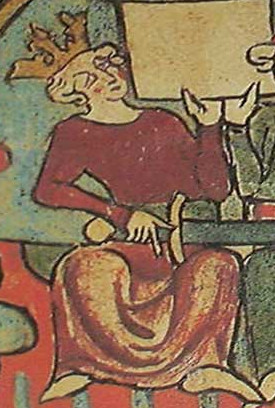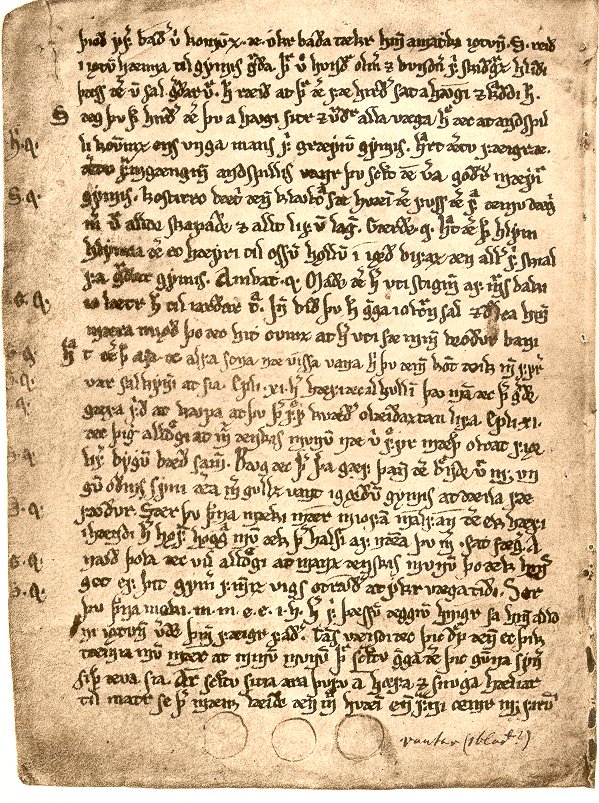|
Melkólfs Saga Ok Solomons Konungs
''Melkólfs saga ok Solomons konungs'' ('the saga of Melkólfur and King Solomon'), whose protagonists are also known as Markólfur and Salomon, is a medieval Icelandic romance-saga. While not straightforwardly a translation, it clearly builds on Continental material, specifically the '' Dialogus Salomonis et Marcolfi''. The saga only survives as a fragment, Copenhagen, Arnamagnæan Collection, AM 696 4to III, fol. 1, comprising two leaves dating from around 1400. The saga was also found in Stockholm, NKS 331 8vo, but that copy is now lost. However, another saga of similar origins, known in scholarship as ''Salomons saga og Markólfs'', also circulated later in Icelandic literary tradition. Editions and translations * Jackson, Jess H., 'Melkólfs saga ok Salomons konungs', in ''Studies in Honor of Albert Moray Sturtevant'' (Lawrence: University of Kansas Press, 1952), pp. 108-11. * John Tucker, ‘Melkólfs saga ok Salomons konungs’, ''Opuscula'', 10 Bibliotheca Arnamagnæana ... [...More Info...] [...Related Items...] OR: [Wikipedia] [Google] [Baidu] |
Chivalric Sagas
The ''riddarasögur'' (literally 'sagas of knights', also known in English as 'chivalric sagas', 'romance-sagas', 'knights' sagas', 'sagas of chivalry') are Norse prose sagas of the romance genre. Starting in the thirteenth century with Norse translations of French '' chansons de geste'' and Latin romances and histories, the genre expanded in Iceland to indigenous creations in a similar style. While the ''riddarasögur'' were widely read in Iceland for many centuries they have traditionally been regarded as popular literature inferior in artistic quality to the Icelanders' sagas and other indigenous genres. Receiving little attention from scholars of Old Norse literature, many remain untranslated. The production of chivalric sagas in Scandinavia was focused on Norway in the thirteenth century and then Iceland in the fourteenth. Vernacular Danish and Swedish romances came to prominence rather later and were generally in verse; the most famous of these are the Eufemiavisorna, them ... [...More Info...] [...Related Items...] OR: [Wikipedia] [Google] [Baidu] |
Dialogus Salomonis Et Marcolfi '' (c. 1480), collection of Latin fables
{{disambig ...
Dialogus (Latin for dialogue) can refer to: * ''Dialogus de oratoribus'' (c. 100 AD), treatise on rhetoric attributed to Tacitus * ''Dialogus de musica'' (c. 11th c.), music treatise formerly attributed to Odo of Arezzo * ''Dialogus de Scaccario'' (12th c.), treatise on the English Exchequer * ''Dialogus super auctores'' (c. 1130), an introduction to the classics by Conrad of Hirsau * ''Dialogus creaturarum ''Dialogus creaturarum'' (more properly ''Dialogus creaturarum optime moralizatus'' or ''Dyalogus creaturarum moralizatus''), is a collection of 122 Latin-language fables and, as the title implies, dialogues of creatures. The fables are organis ... [...More Info...] [...Related Items...] OR: [Wikipedia] [Google] [Baidu] |
Chivalric Sagas
The ''riddarasögur'' (literally 'sagas of knights', also known in English as 'chivalric sagas', 'romance-sagas', 'knights' sagas', 'sagas of chivalry') are Norse prose sagas of the romance genre. Starting in the thirteenth century with Norse translations of French '' chansons de geste'' and Latin romances and histories, the genre expanded in Iceland to indigenous creations in a similar style. While the ''riddarasögur'' were widely read in Iceland for many centuries they have traditionally been regarded as popular literature inferior in artistic quality to the Icelanders' sagas and other indigenous genres. Receiving little attention from scholars of Old Norse literature, many remain untranslated. The production of chivalric sagas in Scandinavia was focused on Norway in the thirteenth century and then Iceland in the fourteenth. Vernacular Danish and Swedish romances came to prominence rather later and were generally in verse; the most famous of these are the Eufemiavisorna, them ... [...More Info...] [...Related Items...] OR: [Wikipedia] [Google] [Baidu] |
Icelandic Literature
Icelandic literature refers to literature written in Iceland or by Icelandic people. It is best known for the sagas written in medieval times, starting in the 13th century. As Icelandic and Old Norse are almost the same, and because Icelandic works constitute most of Old Norse literature, Old Norse literature is often wrongly considered a subset of Icelandic literature. However, works by Norwegians are present in the standard reader ''Sýnisbók íslenzkra bókmennta til miðrar átjándu aldar'', compiled by Sigurður Nordal on the grounds that the language was the same. Early Icelandic literature The medieval Icelandic literature is usually divided into three parts: *Eddic poetry *Sagas *Skaldic poetry The ''Eddas'' There has been some discussion on the probable etymology of the term "Edda". Most say it stems from the Old Norse term ''edda'', which means great-grandmother, but some see a reference to Oddi, a place where Snorri Sturluson Snorri Sturluson ( ; ; 1179 – 22 S ... [...More Info...] [...Related Items...] OR: [Wikipedia] [Google] [Baidu] |

